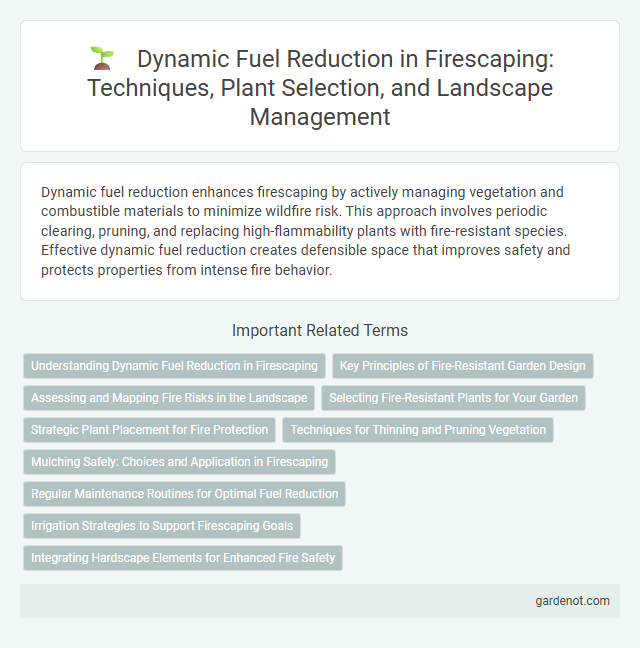Dynamic fuel reduction enhances firescaping by actively managing vegetation and combustible materials to minimize wildfire risk. This approach involves periodic clearing, pruning, and replacing high-flammability plants with fire-resistant species. Effective dynamic fuel reduction creates defensible space that improves safety and protects properties from intense fire behavior.
Understanding Dynamic Fuel Reduction in Firescaping
Dynamic fuel reduction in firescaping involves strategically managing vegetation and organic materials to minimize wildfire risk by altering fuel loads over time. This practice includes targeted pruning, thinning, and removal of combustible materials to disrupt fire spread and intensity. Understanding dynamic fuel reduction enables property owners to create defensible spaces that protect structures and enhance landscape resilience against wildfires.
Key Principles of Fire-Resistant Garden Design
Dynamic fuel reduction in firescaping emphasizes strategic plant selection, spacing, and maintenance to minimize combustible material. Incorporating fire-resistant plants with high moisture content and low resin levels reduces fire intensity and spread. Regular pruning and removal of dead vegetation maintain plant health and create defensible space critical for fire-resistant garden design.
Assessing and Mapping Fire Risks in the Landscape
Dynamic fuel reduction relies on detailed assessing and mapping fire risks across the landscape to prioritize treatment zones effectively. Geospatial technologies integrate vegetation type, fuel load, topography, and historical fire data to create precise risk models. These models enable targeted interventions that reduce fire intensity and spread while preserving ecological balance.
Selecting Fire-Resistant Plants for Your Garden
Selecting fire-resistant plants for your garden plays a crucial role in dynamic fuel reduction by minimizing combustible vegetation near structures. Species such as succulents, native grasses, and deciduous shrubs typically contain higher moisture content and lower volatile oils, reducing fire intensity and spread. Integrating these plants into landscape design enhances safety while maintaining aesthetic appeal and environmental resilience.
Strategic Plant Placement for Fire Protection
Strategic plant placement in firescaping targets dynamic fuel reduction by positioning fire-resistant and low-flammability vegetation to interrupt wildfire pathways and lower flame intensity near structures. Incorporating widely spaced, moisture-rich species with high ignition thresholds creates defensible space that slows advancing fire fronts and reduces ember accumulation. Optimizing plant selection and arrangement enhances fire protection by minimizing continuous fuel loads and promoting safer evacuation zones.
Techniques for Thinning and Pruning Vegetation
Dynamic fuel reduction in firescaping employs thinning and pruning techniques to minimize wildfire risks by removing excess vegetation and lowering fuel load. Selective thinning targets overcrowded branches and small trees, improving airflow and reducing ladder fuels that facilitate fire spread. Pruning involves cutting lower tree limbs to raise the canopy height, preventing ground fires from climbing into the treetops and intensifying fire behavior.
Mulching Safely: Choices and Application in Firescaping
Dynamic fuel reduction through mulching in firescaping enhances fire resistance by creating a protective barrier that slows fire spread. Choosing non-volatile, coarse mulch materials such as hardwood chips and applying them in a 2-3 inch layer minimizes ignition risk while preserving soil moisture. Proper placement away from direct plant bases and structures further reduces fuel continuity and enhances landscape defensibility against wildfires.
Regular Maintenance Routines for Optimal Fuel Reduction
Dynamic fuel reduction relies heavily on regular maintenance routines such as controlled pruning, debris removal, and vegetation thinning to minimize wildfire risks. Consistent inspection of fire-prone areas ensures accumulation of flammable materials is managed effectively, promoting landscape resilience. Integrating these maintenance practices within a firescaping plan enhances overall ecosystem health while reducing potential fire intensity.
Irrigation Strategies to Support Firescaping Goals
Irrigation strategies play a crucial role in dynamic fuel reduction by maintaining healthy, fire-resistant vegetation that supports firescaping goals. Efficient watering techniques, such as drip irrigation and timing irrigation during cooler parts of the day, reduce plant stress and limit excess growth that could serve as wildfire fuel. Integrating smart irrigation systems with native, drought-tolerant plants ensures optimal moisture levels, helping to create defensible spaces that mitigate fire risk while conserving water resources.
Integrating Hardscape Elements for Enhanced Fire Safety
Dynamic fuel reduction in firescaping involves strategically integrating hardscape elements such as stone pathways, gravel beds, and retaining walls to create effective firebreaks that hinder wildfire spread. These non-combustible surfaces reduce available combustible material near structures, significantly enhancing fire safety by disrupting continuous fuel sources. Incorporating hardscape materials into landscape design not only minimizes ignition risk but also supports sustainable fire-resistant landscaping practices.
Dynamic fuel reduction Infographic

 gardenot.com
gardenot.com